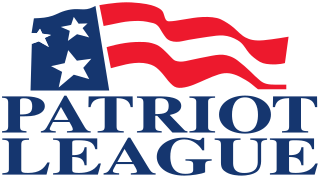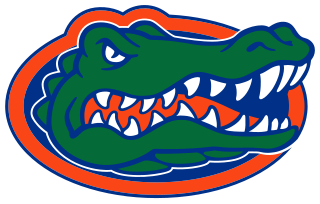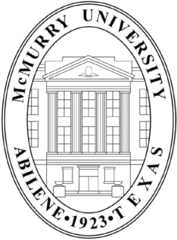
The Patriot League is a collegiate athletic conference comprising private institutions of higher education and two United States service academies based in the Northeastern United States. Outside the Ivy League, it is among the most selective groups of higher education institutions in the NCAA, and has a very high student-athlete graduation rate for both the NCAA graduation success rate and the federal graduation rate.

The Metro Atlantic Athletic Conference is a collegiate athletic conference affiliated with NCAA Division I. Of its current 11 full members, 10 are located in three states of the northeastern United States: Connecticut, New Jersey, and New York. The other member is in Maryland.

The West Coast Conference (WCC) — known as the California Basketball Association from 1952 to 1956 and then as the West Coast Athletic Conference until 1989 — is a collegiate athletic conference affiliated with NCAA Division I consisting of ten member schools across the states of California, Oregon, Utah, and Washington.

The Florida Gators are the intercollegiate athletic teams that represent the University of Florida, located in Gainesville. The University of Florida, its athletic program, its alumni and its sports fans are often collectively referred to as the "Gator Nation." The Gators compete in the National Collegiate Athletic Association (NCAA) and the Southeastern Conference (SEC) and are consistently ranked among the top college sports programs in the United States. The University of Florida currently fields teams in nine men's sports and twelve women's sports.

McMurry University is a private Methodist university in Abilene, Texas. It was founded in 1923 and named after William Fletcher McMurry. The university offers forty-five majors in the fields of fine arts, humanities, social and natural sciences, education, business, and religion, and nine pre-professional programs, including nursing, dentistry, medicine, pharmacy, veterinary, and law.
Mid-major is a term used in American college sports at the NCAA Division I level, particularly men's basketball, to refer to athletic conferences that are not among the ACC, AAC, Big East, Big 10, Big 12, Pac-12, and SEC, which are alternatively referred to as "high majors". The term "mid-major" was coined in 1977 by Jack Kvancz, the head coach of men's basketball team at Catholic University. NCAA neither acknowledges nor uses the terms "major" or "mid-major" to differentiate between Division I athletic conferences. Some schools and fans consider it offensive and derogatory, while others embrace the term.
Redshirt, in United States college athletics, is a delay or suspension of an athlete's participation in order to lengthen their period of eligibility. Typically, a student's athletic eligibility in a given sport is four seasons, aligning with the four years of academic classes typically required to earn a bachelor's degree at an American college or university. However, in a redshirt year, student athletes may attend classes at the college or university, practice with an athletic team, and "suit up" for play – but they may compete in only a limited number of games. Using this mechanism, a student athlete has at most five academic years to use the four years of eligibility, thus becoming what is termed a fifth-year senior.

The Wake Forest Demon Deacons are the intercollegiate athletic teams that represent Wake Forest University, located in Winston-Salem, North Carolina. They compete at the National Collegiate Athletic Association (NCAA) Division I level as a member of the Atlantic Coast Conference (ACC).

Rice University athletic teams are known as the Rice Owls. The name comes from the owls in Rice's crest. Rice participates in NCAA Division I athletics. A member of Conference USA, Rice sponsors teams in seven men's and seven women's NCAA sanctioned sports. Rice was a member of the Southwest Conference until its breakup in 1996. Rice then joined the Western Athletic Conference before joining C-USA on July 1, 2005, and has since announced it will move to the American Athletic Conference in 2023. The women's swimming team moved to The American in 2022 after C-USA dropped women's swimming & diving. Rice is the fifth-smallest school competing in NCAA Division I FBS football measured by undergraduate enrollment, just above the University of Tulsa's 2,756 and the three FBS United States service academies's approximate 4,500. Rice's rivals include the cross-town Houston Cougars.
The Butler Bulldogs men's basketball team represents Butler University in Indianapolis, Indiana. The school's team currently competes in the Big East Conference. They play their home games at Hinkle Fieldhouse.

The Gonzaga Bulldogs are an intercollegiate men's basketball program representing Gonzaga University. The school competes in the West Coast Conference in Division I of the National Collegiate Athletic Association (NCAA). The Gonzaga Bulldogs play home basketball games at the McCarthey Athletic Center in Spokane, Washington, on the university campus.

The Loyola Marymount Lions are the athletic teams that represent Loyola Marymount University, a Jesuit institution in Los Angeles, California. The school competes in NCAA Division I and the West Coast Conference.

The Holy Cross Crusaders are the athletic teams representing the College of the Holy Cross. They compete in NCAA Division I, primarily as members of the Patriot League. In ice hockey, a sport not sponsored by the Patriot League for either sex, the Crusaders are members of two other leagues, with men competing in the Atlantic Hockey Association and women in Hockey East. The men's rowing team is part of the Eastern Association of Rowing Colleges. Of its 25 varsity teams, Holy Cross supports 12 men's and 13 women's sports, giving Holy Cross the largest ratio of teams-per-enrollment in the country. Holy Cross's athletic teams for both men and women are known as the Crusaders.

The Western Washington Vikings represent Western Washington University in intercollegiate sports in the Great Northwest Athletic Conference of the NCAA Division II with the exception of the women's rowing team which is a member of the Northwest Collegiate Rowing Conference. WWU has been an official member of NCAA Division II since September 1998.

Leon Paul Rice is an American college basketball coach, and the head men's basketball coach at Boise State University of the Mountain West Conference. He replaced Greg Graham as head coach of the Broncos on March 26, 2010.
The 2011–12 West Coast Conference men's basketball season begins with practices in October 2011 and ends with the 2012 West Coast Conference men's basketball tournament from February 29- March 5, 2012 at the Orleans Arena in Las Vegas. The regular season begins on the weekend of November 11, with the conference schedule starting on December 29.

The 2017–18 Gonzaga Bulldogs men's basketball team represented Gonzaga University in the 2017–18 NCAA Division I men's basketball season. The team was led by head coach Mark Few, who was in his 19th season as head coach. The team played its home games at McCarthey Athletic Center in Spokane, Washington. This was the Bulldogs 38th season as a member of the West Coast Conference. They finished the season 32–5, 17–1 in WCC play to win the WCC regular season championship. They defeated Loyola Marymount, San Francisco and BYU to become champions of the WCC tournament. They received the WCC's automatic bid to the NCAA tournament where they defeated UNC Greensboro and Ohio State to advance to the Sweet Sixteen where they lost to Florida State.

The 2018–19 Gonzaga Bulldogs men's basketball team represented Gonzaga University, located in Spokane, Washington. in the 2018–19 NCAA Division I men's basketball season. The team was led by head coach Mark Few, in his 20th season as head coach. This was the Bulldogs' 15th season at the on-campus McCarthey Athletic Center and 39th season as a member of the West Coast Conference. They finished the season 33-4, 16-0 to finish in 1st place. In the WCC Tournament, they defeated Pepperdine in the semifinals before losing in the championship game to Saint Mary’s. They received an at-large bid to the NCAA Tournament where they defeated Fairleigh Dickinson, Baylor and Florida State to make the Elite Eight. In the Elite Eight, they lost to Texas Tech.

The 2020–21 West Coast Conference men's basketball season began with practices in September 2020 and ended with the 2021 West Coast Conference men's basketball tournament in March 2021. This was the 70th season for WCC men's basketball, and the 32nd under its current name of "West Coast Conference". The conference was founded in 1952 as the California Basketball Association, became the West Coast Athletic Conference in 1956, and dropped the word "Athletic" in 1989.

The 2022–23 Gonzaga Bulldogs men's basketball team represents Gonzaga University, located in Spokane, Washington, in the 2022–23 NCAA Division I men's basketball season. The team, also unofficially nicknamed the "Zags", is led by head coach Mark Few, in his 24th season as head coach, and played home games at the on-campus McCarthey Athletic Center as members of the West Coast Conference (WCC). The Zags finished the regular season 26–5, 14–2 in WCC play to win a share of the regular season championship.














